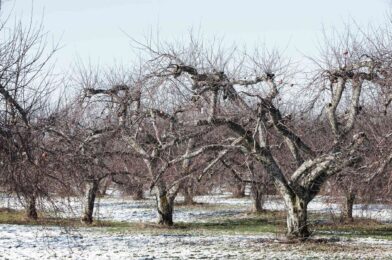Wolf Man VIOLENCE/WORSE 7
– A woman leads a man who is undergoing a transformation and a young girl outside in the dark to a truck, starts the engine and tries to drive away while some creature jumps on the hood, breaks through the windshield, pulls the shifter, tries to grab the woman and she cuts her arm with a knife; the three people in the truck escape and climb to the top of the greenhouse, the girl almost falls, and the man jumps, distracting the creature, and they fight off-screen (we hear growls and howls). A man opens the door and a creature from outside rushes in and grapples with him; they fight by biting and cutting each other, a woman stabs the creature in the shoulder, and one character is bitten on the throat (we see a bloody wound with blood pulsating from it) and dies. A man undergoing transformation approaches a woman and a young girl, and the woman cuts his hand when he reaches for the child (we see blood); he grabs the blade and drags his hand across it (we see a lot of blood). A woman and a girl hide in a barn, and a man undergoing a transformation enters and threatens them from the shadows; he steps into a trap that tightens around his ankle, bites off his own leg to free himself (we see blood and torn tissue, and the severed foot remains in the trap), runs on all fours to chase a woman and a young girl into a deer blinds him and when they break down the door , the woman shoots him and he falls to the ground (we see blood on his face and mouth).
► A man leaves the house and we hear howls and whoops in the distance; we see him transform and become wolfish, his hands change to look more like paws and he retracts his lower jaw (we hear bones crunching) while fur grows on his back. The man’s hand is very bloody and the woman removes the bandage to reveal the disintegrating flesh under the bandage and he rushes to the corner where he chews his hand (we hear growls and tears, we see his bloody mouth and face and a tooth pops out of his mouth); the woman looks on in horror.
► A man driving a truck at night swerves to miss what appears to be a man standing in the road; the truck veers off the road and hangs on its side in the trees; a man opens his door and falls out and onto the ground where something grabs him and drags him off-screen (we see a bloody gash on his stomach and hear growls and slashes); another man in the truck is scratched on the arm by an animal (we see blood) and he, his wife and child run through the woods to find a house as the animal chases him. A man hears noises outside the house and we see something moving by the window; the man stands in the doorway listening, the creature grabs his leg through the dog door and tries to pull him out until the woman hits the creature several times with a hammer and the man backs away and loses consciousness.
► A man and a young man in the forest hear strange noises and heavy footsteps nearby; the man sends the boy to the blind deer, the man follows him and they wait until outside we hear an animal noise and a loud bang drives the animal away; a man sees something moving in the distance and shoots at it (we hear a roar but see nothing hit). A man hears a woman’s voice, but cannot make out the words she utters; we only hear sounds when she speaks and he is unable to form words when he tries to speak. A man takes aim at a deer in the woods and the deer moves out of sight; The young man runs to get a better vantage point and sees something strange through his page as he shoots.
► The man’s face begins to change, his hair begins to fall out and the shape of his hands changes. The woman finds a bloody wound on the man’s hand (we see the bloody wound and the swollen tissue around it) and disinfects and bandages it. The man bites down on a tough piece of jerky and spits out a bloody tooth. A man accidentally hits his arm with a hammer and groans in pain. A man hears loud noises and movements in the closet and when he opens the door we see a large spider jumping on the wall; the man seems feverish and congested.
► A man, woman and girl in a truck pull up at a gate, and a man with a rifle is seen in the shadow of a blind deer; walks towards the truck, and the woman protests, telling the man in the truck to leave.
► A man shouts at his young son and shakes his arm. A man shouts at his young son when he doesn’t pay attention to him and says that it’s not hard to die. A man tells his young son that the mushrooms in the forest are called “death caps” because they are poisonous. A man yells at his young daughter for climbing the road barriers near traffic and when she jumps, she runs into a man who is also yelling at her. A man wakes up his son by shouting “Ten huts!” and the boy hurried to make his bed and dress to go hunting. A man tells another man over the radio, “I saw it,” after an encounter with an animal and says he wants to protect his son. A woman radios for help and says, “My husband is infected.” A man receives a document that his father has been officially declared dead. A man and a woman talk about whether they are happy. We read about the disappearance of a hiker in Oregon and the suspicion that he was infected with a virus transmitted by animals. The sign reads: “Move. There is nothing here worth dying for.”
► Squealing sounds follow a wasp attacked by ants. The man vomits a lot of blood (we see the shell and blood) and we understand that he has bitten off the creature’s finger (we see the severed finger with the bone exposed in a pool of vomited blood). A man complains about the smell of something and opens the door to find hanging pieces of meat and some meat. In the distance you can see the bloody remains of a deer with blood and exposed ribs. A deer skin is seen draped over the sofa and a deer head is shown mounted and hanging on the wall. The man looks sick and urinates on the floor; we see a puddle forming at his boot. The man’s hands change shape and we see his nails pop out and in their place grow claws followed by blood. A severed human hand is depicted on the ground.




:max_bytes(150000):strip_icc():format(jpeg)/51.ColdSpringHarborbyChangoCo.-PrimaryBathroomWidecopy-e436f2a8237d45b5bf329f3203c61781.jpg)






:max_bytes(150000):strip_icc():format(jpeg)/GettyImages-1347250222-0022d83124534f09aa157d5db65ebdfe.jpg)









:max_bytes(150000):strip_icc():format(jpeg)/GettyImages-185072501-6875a82e4e184508957d22639a6cced2.jpg)

